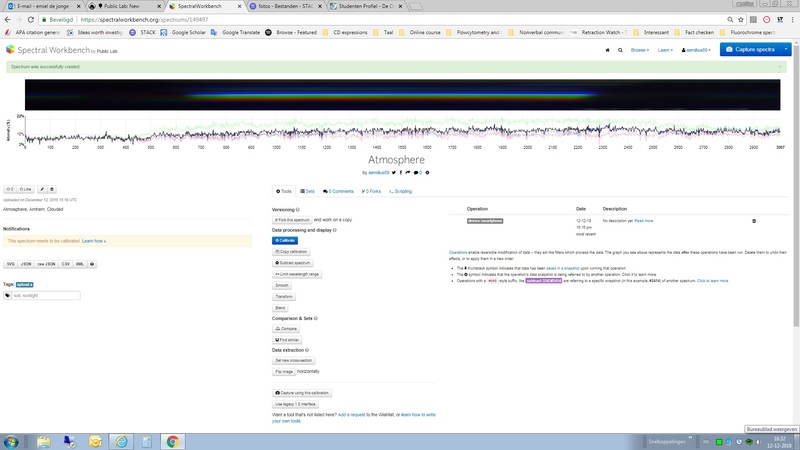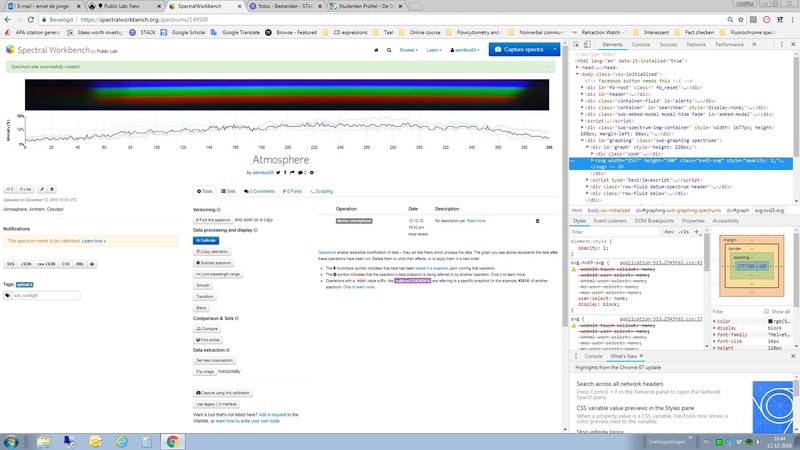Spectralworkbench Blog

Important Update from Public Lab
Dear Friends and Supporters:
With a challenging economy and the impacts of the ongoing pandemic affecting everyday life, we’re grateful for your continued support and engagement with Public Lab.
Unfortunately, these are difficult times for all of us. Due to funding challenges, we have made the tough but necessary decision to scale back programming and take certain services offline. We are doing our best to sustain core programming and support for our community. And Public Lab needs your help.
Given the current situation, we’ve made important changes to our programs. These include:
- Reduced capacity for our team. We will engage less on new projects, and focus on sustaining our place-based fellowship, community science outreach, and environmental education programs.
- Virtual programming will change, including the hosting of Public Lab’s Open Call. The Tuesday Open Call will still occur on a weekly basis, hosted by program team leads each week. Changes to this schedule will be announced on publiclab.org.
- Reduced capacity at our Kits Store. Kits fulfillment and shipping will be a minimum of two to three weeks from order date, and certain kits will be pre-order only. Specific changes will be outlined in the store.
- Mapknitter.org and SpectralWorkbench.org will go offline August 15th. While we anticipate a functional return of these sites, we do not have an estimated date at this time.
- The November 2022 Barnraising will be rescheduled to Spring of 2023.
We are dedicated to serving this community, and hope to resume programming to its regular capacity over the next several months. If you’re able, please consider making a gift today to help sustain the Public Lab team, and ongoing community support and educational outreach.
Over the last 2+ years, we’ve been reminded of how interconnected we all are. Thank you for being part of our community. Without you, none of this is possible.
Be Safe and Well,
Jordan Macha
Executive Director, Public Lab
Follow related tags:
education events kits spectralworkbench

NoIR Camera Spectral Response
Introduction
As I was going to assemble an infragram pi, I realized I had a magenta filter instead of a red one. Having recently configured my spectrometer to work with filters, I can now test the PiCamera's wavelength range and color filter response in the same experiment. I searched through the archives, and to my knowledge, nobody has tested this either on Public Lab or the rest of the internet. The only thing I found is this post on the RPi forums. So with a Pi powered spectrometer at my disposal I compared images taken on both cameras with and without filters of light from a CFL.
This is only a preliminary experiment, a more refined one is on the way. Some things immediately obvious is the fact that CFLs are manufactured to emit a majority of light in the visible spectrum so a better light would be an incandescent for looking at more of the IR spectrum.
My spectrometer:
The design for the spectrometer portion takes the mounting hardware from a previous spectrometer I designed, and it uses the geometry of PublicLab's Lego spectrometer. I use bulkheads that house: a 1000 lines/mm diffraction grating, the PiCamera, color filters, and a slit from razor blades. Designs are available in one of my past posts. I put the color filters in front of the razor blades because it fits best, but this should be tested in the next iteration of this experiment.

The spectra:
A total of six spectra were captured between two piCameras and two filters. Links to all my spectralworkbench captures will be at the end.
First, a comparison of the two cameras without filters.


The spectra could be calibrated better, but for now we can see the NoIr camera has a bit more intensity past 650 nm or so with the intensity dropping under 10% at about 725 nm. Additionally we can subtract the regular camera's spectrum from the noir camera to better view the wavelengths the IR filter normally attenuates.

Here the little bump in intensity at 750 nm becomes more apparent.
Color filters with the camera experiments.
I calibrated my spectra with the blue filters of each test run. The blue filters out the red light which makes it easy to calibrate on spectral workbench, however my calibration might not be accurate as the zeroth order seems to be a bit to the left of where it should be. Without an incandescent to emit more IR wavelengths, the color filters do not show much, especially without NIR radiation from the source. The image taken on the NoIR camera with a blue filter shows what the blue and red sensors detect in NIR, again demonstrating a small increase in intensity at around 700-750 nm.

Conclusion
The NoIR camera can get spectra up to at least 725 nm in the NIR spectrum, this is limited by the source in this experiment. With a larger control of light sources better results can be visited. Filters can be tested on spectral workbench to find out which wavelengths they can attenuate. Darkness in the spectrometer filters out the noise. CFLs might not make the best light sources for NIR experiments because they do not emit enough IR light for the sensor to effectively detect.
Next steps in this experiment:
- Test the filters available in the Public Lab store
- Test other light sources which may output more light in the NIR band (incandescents, sunlight)
- Refine the design, make it darker
- Filter positioning
- Play with the camera's white balance settings, this may be a source for error
https://spectralworkbench.org/spectrums/188442 https://spectralworkbench.org/spectrums/188443 https://spectralworkbench.org/spectrums/188444 https://spectralworkbench.org/spectrums/188446 https://spectralworkbench.org/spectrums/188447 https://spectralworkbench.org/spectrums/188448
Follow related tags:
spectralworkbench spectrometry raspberrypi picamera
How can I get the menu to calibrate SpectralWorkbench?
I would like to use SpectralWorkbench in a workshop for students. At Public Lab I'm logged in with a google account. When I start SpectralWorkbench, there is no menu or button for calibration.
How can I start the calibration menu?
Thanks a lot!
Jutta
Follow related tags:
calibration spectralworkbench spectrometry question:spectrometry
Spectral Workbench 1.0 seems much more stable than 2.0 and works well for the basic analysis I am trying to do, can I get access to 1.0 without being pushed to 2.0?
I need to have offline access to spectral workbench when in the Amazon rainforest this coming January. I am using a home-built 3D printed spectrometer with iPhone 6s as my detector. The 2.0 interface is very slow and glitchy. For example, it seems to always flip my images to place the blue line on the right even though they are collected with it on the left. If I try to pre-flip them and anticipate it re-flipping them, then the software doesn't flip them at all. I can't win. Also, the tools seem more reliable for calibration and using an old calibration on the 1.0 interface. In my admittedly limited use of the software, I would say 2.0 has been pushed out way too soon when 1.0 is much more functional. Am I missing something? Is there a way to have access to 1.0 interface without being pushed after every operation to the 2.0 interface?
Follow related tags:
spectrometer spectralworkbench spectral-workbench-api question:spectral-workbench
Uploaded pictures always stays vertical
Hello,
When taking a picture with the phone or tablet with the foldable spectrometer. I upload it and the picture is always processed as vertical. Even if you check or uncheck the "Spectrum is vertical" box. It will always insert the spectrum in the below manner. It does so on a desktop computer with windows 7, windows tablet with windows 10 and my android phone. I also found out that trying to use the "flip image" option does not do anything.

For a moment I thought that the picture was to big, so I made it smaller. But it still happened. So I included the java inspection.

With kind regards,
Emiel de Jonge
Follow related tags:
spectralworkbench question:website
Diffraction grating (200nm - 400nm) & Light, Vendor/Source Identification
Piecing together a DIY spectrometer and sourcing: diffraction grating (200nm - 400nm) and the appropriate light source. The target wavelengths are roughly: 220nm, 230nm, 250nm, 270nm and 280nm
I have located the recommended software to perform remote analysis (https://github.com/classimago/Pi-Spectrometer/tree/master).
This spectrometer would be used inline with a batch and possible continuous process.
Are there any vendors/sources for the proper diffraction grating?
What light source is recommended (Vendor/Source)?
The DIY equipment will display the wavelength that is absorbed as a black band. Is there a better way to approach this?
Thank you all for your help
Follow related tags:
spectrometer spectralworkbench uvc question:general